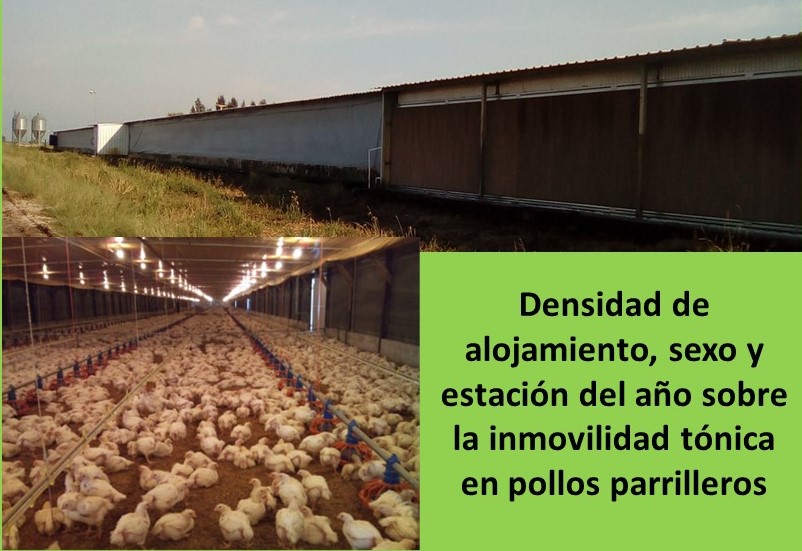Densidad de alojamiento, sexo y estación del año sobre la inmovilidad tónica en pollos parrilleros
Densidad de alojamiento, sexo y estación del año sobre la inmovilidad tónica en pollos parrilleros


Esta obra está bajo una licencia internacional Creative Commons Atribución-NoComercial-CompartirIgual 4.0.
Mostrar biografía de los autores
Objetivo. Evaluar el efecto de la densidad de alojamiento, la época del año y el sexo sobre el tiempo de latencia y el número de intentos de inducción de la inmovilidad tónica en pollos parrilleros en un sistema de producción industrial. Material y métodos. Se empleó un total de 216.000 pollos híbridos comerciales Cobb500, criados en lotes mixtos, 54.000 en cada una de las cuatro estaciones del año, en galpones oscurecidos de ventilación forzada tipo túnel, bajo dos densidades de alojamiento: estándar (14 pollos/m2) y reducida (12 pollos/m2). El día 35 se extrajeron 90 aves de cada sexo, de cada densidad y en cada estación del año y se realizó la prueba de inmovilidad tónica, registrándose el tiempo de latencia en segundos (s) y el número de intentos de inducción. Resultados. La densidad afectó significativamente (p<0,005) el tiempo de latencia, con valores de mediana (Mna) y rango intercuartílico (RI) de 72 s (38-143) para la densidad estándar y 63 s (36-127) para la densidad reducida. En el número de intentos la diferencia fue marginalmente significativa. No se observaron diferencias significativas entre sexos ni entre estaciones en ninguna de las dos variables. Conclusiones. La duración de la inmovilidad tónica es una herramienta útil como indicador de miedo en situaciones específicas. La disminución de la densidad reduce el período de latencia y se requieren más intentos de inducción en pollos, en tanto que el sexo y la estación del año no producen el mismo efecto.
Visitas del artículo 299 | Visitas PDF
Descargas
- Mellor DJ. Operational details of the five domains model and its key applications to the assessment and management of animal welfare. Animals. 2017; 7(8):60. https://doi.org/10.3390/ani7080060
- Jones RB. Fear and adaptability in poultry: insights, implications and imperatives. Worlds Poult Sci J. 1996; 52(2):131-174. https://doi.org/10.1079/WPS19960013
- Gilman TT, Marcuse FL. Animal hypnosis. Psychol. Bull. 1949; 46(2):151-165. https://doi.org/10.1037/h0060434
- Nash RF, Gallup GG. Habituation and tonic immobility in domestic chickens. J. Comp. Physiol. Psychol. 1976; 90(9) 870-876. https://doi.org/10.1037/h0077265
- Tong HB, Lu J, Zou JM, Wang Q, Shi SR. Effects of stocking density on growth performance, carcass yield, and immune status of a local chicken breed. Poult. Scie. 2012; 91(3):667-673. https://doi.org/10.3382/ps.2011-01597
- Elfwing M, Nätt D, Goerlich-Jansson VC, Persson M, Hjelm J, Jensen P. Early stress causes sex-specific, life-long changes in behaviour, levels of gonadal hormones, and gene expression in chickens. PLoS One. 2015; 10(5):e0125808. https://doi.org/10.1371/journal.pone.0125808
- Sinkalu VO. Melatonin modulates tonic immobility and vigilance behavioural responses of broiler chickens to lighting regimens during the hot-dry season. Physiol. Behav. 2016; 165:195-201. https://doi.org/10.1016/j.physbeh.2016.07.019
- Jones RB, Faure JM. Sex and strain comparisons of tonic immobility (“righting time”) in the domestic fowl and the effects of various methods of induction. Behav. Process. 1981; 6(1):47-55. https://doi.org/10.1016/0376-6357(81)90015-2
- Wang S, Ni Y, Guo F, Fu W, Grossmann R, Zhao R. Effect of corticosterone on growth and welfare of broiler chickens showing long or short tonic immobility. Comp Biochem Phys A. 2013; 164(3), 537-543. https://doi.org/10.1016/j.cbpa.2012.12.014
- Altan O, Seremet C, Bayraktar H. The effects of early environmental enrichment on performance, fear and physiological responses to acute stress of broiler. Arch. Geflügelkunde. 2013; 77(1):23-28. https://www.european-poultry-science.com/The-effects-of-early-environmental-enrichment-on-performance-fear-and-physiological-responses-to-acute-stress-of-broiler,QUlEPTQy
- Uzum MH, Oral Toplu HD. Effects of stocking density and feed restriction on performance, carcass, meat quality characteristics and some stress parameters in broilers under heat stress. Rev Med Vet. 2013; 164:546-554. https://www.revmedvet.com/2013/RMV164_546_554.pdf
- Tahamtani FM, Pedersen IJ, Toinon C, Riber AB. Effects of environmental complexity on fearfulness and learning ability in fast growing broiler chickens. Appl Anim Behav Sci. 2018; 207:49-56. https://doi.org/10.1016/j.applanim.2018.04.005
- Bach MH, Tahamtani FM, Pedersen IJ, Riber AB. Effects of environmental complexity on behaviour in fast-growing broiler chickens. Appl Anim Behav Sci. 2019; 219:104840. https://doi.org/10.1016/j.applanim.2019.104840
- Shields S, Greger, M. Animal welfare and food safety aspects of confining broiler chickens to cages. Animals. 2013; 3(2):386-400. https://doi.org/10.3390/ani3020386
- Das H, Lacin E. The effect of different photoperiods and stocking densities on fattening performance, carcass and some stress parameters in broilers. ISR J VET MED. 2014; 69(4):211-220. http://www.ijvm.org.il/sites/default/files/different_photoperiods_and_stocking_densities.pdf
- Son JH. The effect of stocking density on the behaviour and welfare indexes of broiler chickens. J Agric Sci Technol A. 2013; 3(4A):307. https://doi.org/10.5536/KJPS.2011.38.1.001
- Campbell DL, Hinch GN, Downing JA, Lee C. Fear and coping styles of outdoor-preferring, moderate-outdoor and indoor-preferring free-range laying hens. Appl. Anim. Behav. Sci. 2016; 185:73-77. https://doi.org/10.1016/j.applanim.2016.09.004
- Larsen H, Hemsworth PH, Cronin GM, Gebhardt-Henrich SG, Smith CL, Rault JL. Relationship between welfare and individual ranging behaviour in commercial free-range laying hens. Animal. 2018; 12(11):2356-2364. https://doi.org/10.1017/S1751731118000022
- Archer G. Sex, genetics and test type affect the responses of chickens to fear testing. Int Poult Sci. 2018; 17(7):320-326. https://doi.org/10.3923/ijps.2018.320.326
- Agnvall B, Jöngren M, Strandberg E, Jensen P. Heritability and genetic correlations of fear-related behaviour in red junglefowl–possible implications for early domestication. PloS One. 2012; 7(4):e35162. https://doi.org/10.1371/journal.pone.0035162
- Nätt D, Agnvall B, Jensen, P. Large sex differences in chicken behavior and brain gene expression coincide with few differences in promoter DNA-methylation. PLoS One. 2014; 9(4):e96376. https://doi.org/10.1371/journal.pone.0096376
- Skomorucha I, Sosnówka-Czajka E, Muchacka R. Effect of thermal conditions on welfare of broiler chickens of different origin. Ann Anim Sci. 2010; 10(4):489-497. http://www.izoo.krakow.pl/czasopisma/annals/2010/4/art16.pdf
- Fidan ED, Nazlıgül A, Türkyılmaz MK, Aypak SÜ, Kilimci FS, Karaarslan S, Kaya M. Effect of photoperiod length and light intensity on some welfare criteria, carcass, and meat quality characteristics in broilers. R Bras Zootec. 2017; 46(3):202-210. http://doi.org/10.1590/S1806-92902017000300004
- Egbuniwe IC, Ayo JO, Kawu MU, Mohammed A. Effects of betaine and ascorbic acid on tonic immobility, superoxide dismutase and glutathione peroxidase in broiler chickens during the hot-dry season. J Vet Behav. 2016; 12:60-65. https://doi.org/10.1016/j.jveb.2015.11.001























